The Story of Julie's Sainthood
IMPORTANT DATES
Venerated on June 26, 1889
Blessed on March 19, 1906
Beatified on May 13, 1906
Canonized on June 22, 1969
Miracles Attributed to Julie Billiart
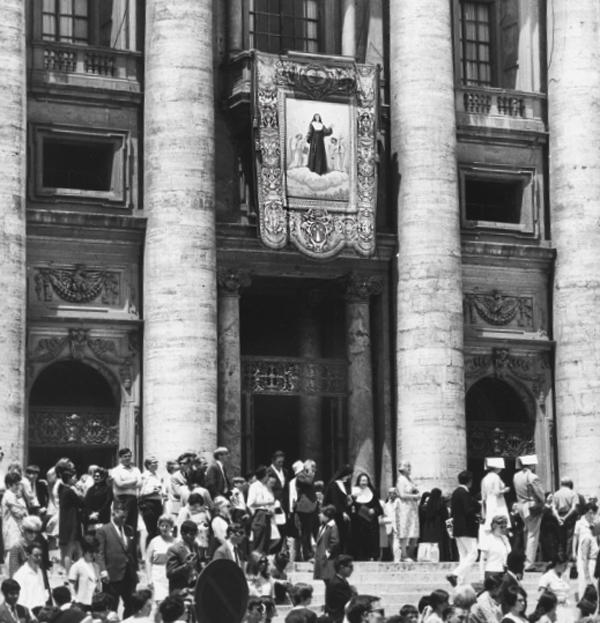 |
| St. Peter Basilica, The Vatican, June 22, 1969 |
On November 20, 1919, in Namur, Belgium, Homer Rhodius lies on his deathbed suffering from renal disease. After receiving the Last Sacraments, he falls into a deep coma. His attending physicians give him less than a day to live while his family continues to pray. They begin a fervent novena and place upon Homer a relic of the Blessed Julie Billiart, presumably supplied by Sister Marie-Ludovica, his daughter and a Sister of the Namur Congregation of the Sisters of Notre Dame. After two days, Homer wakes up. On the fourth day, he can take nourishment. Within a month he returns to work. No sign of his malady ever returns.
On September 29, 1950, a 29-year-old farmer named Otacilio Ribeiro da Silva is shaking with pain. At the town hospital in the village of Mata Virgem in Brazil, he is admitted by Sister Maria Bardona, a Coesfeld Sister of Notre Dame. Sister Mary Ludvine, the hospital’s superior, calls both a priest and a doctor. Sister Ludvine would later write a three-paragraph report on the events of the Otacilio miracle.
Dr. Janh Martins Ribeiro (no relation to the family) orders immediate surgery on Otacilio. The operation reveals a terrible tumor. In the words of Sister Ludvine: “It was hard as a stone and of a dark red color and filled the entire abdomen…The doctor tried to loosen the tumor to remove it, but from no side could it be moved. Almost without knowing what to do, he tried over and over to make the tumor yield and worked at it for a long time. But it was impossible.”
Sister Ludvine, Sister Bardona, and Sister Maria Adelaide begin to pray to the Blessed Julie for the young man’s healing. In the early morning, Otacilio regains consciousness, and Sister Ludvine tells him of their petitions to Julie. She places a picture of the foundress on the wall and a relic over Otacilio’s incision. She invites him to join them in a novena, which he does.
On either the third or the fourth evening, (Sister Ludvine, years later, could not remember), Otacilio calls out, “Sister, there is something so very unusual. I cannot explain it, but it is quite different.”
“Otacilio,” says Sister Ludvine, making the sign of the cross on his forehead, “the dear God is good. He will be with you this night. Pray to your saint.” Then she leaves him alone.
In the morning, Sister Ludvine finds Otacilio sitting up in bed, smiling. “I could get up,” he says. Shocked, she won’t allow it until the doctor is able to examine him. At 9 a.m. the doctor arrives. He inspects the incision and abdomen.
“What have you done to him?” Dr. Ribeiro asks. He says repeatedly, “What has become of the growth? Where did the growth go?”
A week later Otacilio is released. His parents give the Sisters one and a half kilograms of wax for candles as a gift of gratitude. Otacilio promises, “If the good Lord would give me one more daughter, she shall be called Julie.”
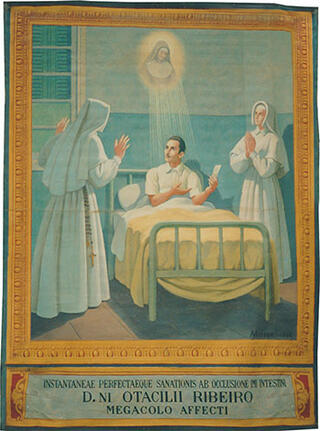 |
|
"Sister, there is something so very unusual. I cannot explain it but it is quite different." — Otacilio |
The Long Road to Canonization
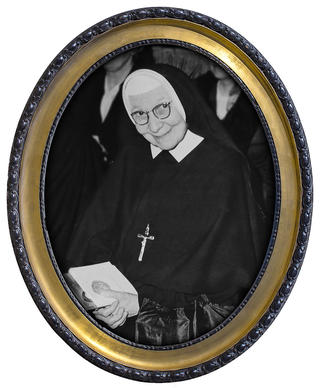 |
| Coesfeld Sister of Notre Dame Mother Mary Verona |
In 1952, Mother Mary Verona, an assistant mother general of the Coesfeld Sisters of Notre Dame was residing in Rome. Mother Verona was familiar with the miraculous healing of Homer Rhodius in 1919 and had been much involved in the decades-long work to canonize Blessed Julie. In her free time, she begins to read the December issue of her congregation’s newsletter. In it is Sister Ludvine’s three-paragraph report of the illness and recovery of a farmer in Brazil, a miraculous incident that occurred two years prior.
Mother Verona immediately consults with the Secretary of the Sacred Congregation of Rites, whom she knows. The Congregation of Rites was tasked with the causes of saints.
The Secretary reads the three paragraphs and requests a more complete report. Sister Ludvine herself complies. Witnesses are interviewed, proceedings held, affidavits sworn. Documents flow back and forth between Rome and the Diocese of Lages, where the purported second miracle is said to have occurred.
Finally, in 1958, the Otacilio miracle in Brazil is authenticated. This prompted Mère Josepha de St. François, Mother General of the Sisters of Notre Dame de Namur, to request an audience with Pope John XXIII to discuss moving forward with the process of canonization.
She receives a disappointing reply. John says to her: “Our good religious are all begging for the canonization of their foundresses. Let them sanctify themselves. That will give greater glory to God.”
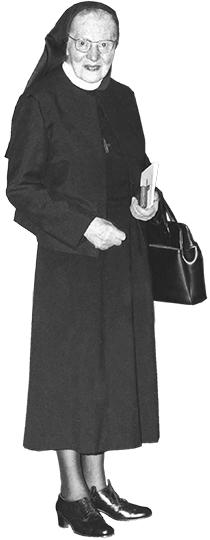 |
| Sister of Notre Dame de Namur Mère Josepha de St. François |
Mère Josepha, in her own words, is “struck with consternation.” Nevertheless, she replies graciously with a note thanking John for his time. A few days later a return note arrives, coming through the pope’s secretary: “…the Sacred Congregation of Rites will be acquainted with your desire.”
From there, efforts were made to reconsider the medical consultation of Homer Rhodius in 1919, which the Vatican had declined to validate at the time. In an historic precedent, a lawyer successfully petitioned for a reversal of the ruling. Fifty years had passed since the first recorded miracle of healing that was attributed to Julie.
Canonization
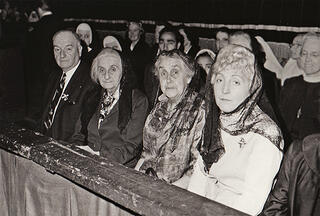 |
| St. Julie Billiart's relatives |
On June 22, 1969, St Peter’s Basilica is filled for the Rite of Canonization. In attendance were Mother Mary Verona, Mère Josepha, Dr. Janh Martins Ribeiro, Billiart family members and 800 Coesfeld Sisters of Notre Dame, Sisters of Notre Dame of Amersfoort, and Sisters of Notre Dame de Namur. All three orders were devoted to Julie Billiart.
Pope Paul VI formally declares Marie Rose Julie Billiart of Cuvilly, France, as the Church’s newest saint—Saint Julie. He offers Communion. Among those receiving it is a mustachioed farmer named Oscalio and his 14-year-old daughter, Julie.
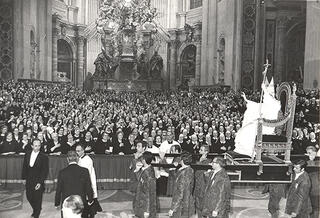 |
| Pope Paul VI greets Sisters of Notre Dam |
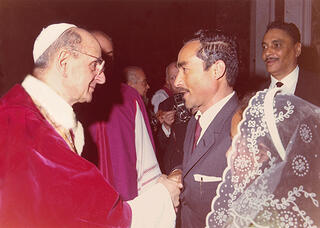 |
| Pope Paul VI and Otacilio Ribeiro |
